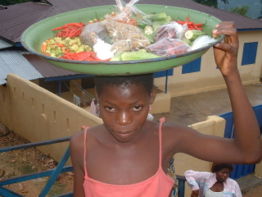Logba language
2007 Schools Wikipedia Selection. Related subjects: Languages
| Logba Ikpana |
||
|---|---|---|
| Spoken in: | Ghana | |
| Region: | Volta Region, north-west of Ho | |
| Total speakers: | 7 500 | |
| Language family: | Niger-Congo Atlantic-Congo Volta-Congo Kwa Nyo Potou-Tano Ghana Togo Mountain Logba |
|
| Language codes | ||
| ISO 639-1: | none | |
| ISO 639-2: | nic | |
| ISO/FDIS 639-3: | lgq | |
| Note: This page may contain IPA phonetic symbols in Unicode. See IPA chart for English for an English-based pronunciation key. | ||
Logba is a Kwa language spoken in the south-eastern Ghana by approximately 7 500 people. The Logba people call themselves and their language Ikpana, which means ‘defenders of truth’. Logba is different from Lukpa of Togo and Benin, which is also sometimes referred to as Logba.
Classification
The first published treatment of Logba was a short grammar by Diedrich Hermann Westermann (1903). Westermann included Logba in his group of Togo Restsprachen (Togo Remnant languages), a terminology adopted by several subsequent researchers. Dakubu and Ford (1988) renamed this cluster the Central Togo languages but since Ring (1995) they are commonly referred to as Ghana Togo Mountain languages. The about fourteen Ghana Togo Mountain languages are part of the Kwa branch of the Niger-Congo phylum.
Geography and demography
The Logba people live in the Volta Region of Ghana, east of the Volta Lake in the mountains of the Ghana-Togo borderland. Most Logba towns and villages are situated along the trunk road from Accra to Hohoe. They include the following settlements: Wuinta, Akusame, Adiveme, Andokɔfe, Adzakoe, Alakpeti, Klikpo, and Tota. Tota is located high in the Ghana Togo Mountains to the east of the Accra-Hohoe road. Alikpeti is the commercial centre of Logba, while Klikpo is traditionally the seat of the head of the Logba people. The Logba people are peasant farmers, producing cassava, maize, yams, and cahs crops like cocoa and coffee. The Logba area is known for its limestone formations, including underground caves with stalagmites and stalactites.
The dominant language in the regio is Ewe, closely followed by Twi. Most Logba people are bilingual in Ewe. South of the Logba area live the Avatime people. Logba is only distantly related to its direct neighbours Avatime and Nyagbo-Tafi; according to Bernd Heine (1968) it is more closely related to the Akpafu and Santrokofi languages spoken northwards.
It is generally agreed that the Logba people are not the original inhabitants of the area they now reside in. There have been two hypotheses as to the origin of the Logba people. Heine (1968, following Debrunner), proposed that the Logba are descendants from the makɔ́ people, having fled south after a defeat in the second half of the 18th century. However, the Logba people themselves relate that they have come together with the Gbe peoples from Ketu. The latter view is advanced also by Dorvlo (2004).
Linguistic features
Logba has a nine vowel system with ATR vowel harmony. Vowel harmony in Logba is root-controlled, which means that the vowels of its nominal prefixes harmonize with the vowels of the root. Vowels are nasalized when they occur in the immediate environment of a nasal consonant.
| . | Front | Central | Back |
|---|---|---|---|
| Near-close | ɪ | ʊ | |
| Open-mid | ɛ | ɔ | |
| Open | a |
| . | Front | Central | Back |
|---|---|---|---|
| Close | i | u | |
| Close-mid | e | o | |
| Open | a |
Logba has a total of 23 consonants. A notable feature of Logba phonology is the opposition between bilabial and labio-dental fricatives, found in various other languages of the region, including Ewe. Logba is a tonal language with two level tones: High and Low. These tones can be combined on one syllable, yielding a Rising or Falling contour tone.
All syllables are open in Logba. Every syllable bears a tone. The basic syllable structure can be rendered as (C1)(C2)V+T, where C = consonant, V = vowel or syllabic nasal, and T = tone. Dorvlo (2004) distinguishes three types of syllables:
- Nucleus only, comprised of a vowel or a syllabic nasal. This type is found only in pronouns and nominal prefixes. Examples: ɛ́-mɔ́ 'they laughed'; ɔ́-zɔ́ 'he/she went'; n-dà 'liquor'.
- Onset and nucleus. This is the most common syllabe type in Logba; most words are of this form. In multisyllabic words, it can occur in all positions. Examples: bà ‘come’; gbà ‘sweep’; bìsí ‘cola nut’
- Complex onset and nucleus. Only /r/ and /l/ occur as the second consonant of the complex onset. This syllable type can also form a word by itself. In multisyllabic words, in can occur in all positions. Examples: à-klɔ́ ‘goat’; trò ‘refuse’; ìvàflí ‘(thing) white’.
